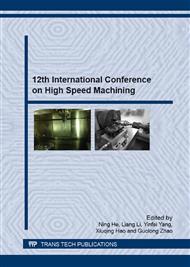p.88
p.94
p.99
p.106
p.112
p.117
p.126
p.132
p.139
Identification of Cutting Shear Stress, Shear and Friction Angles Using Flat End Milling Tests
Abstract:
Orthogonal-to-oblique transformation model, which is formulated based on the cutting database including shear stress, shear and friction angles, can be used to predict cutting forces in high speed milling process and any other machining process. The involved shear stress, shear and friction angles are traditionally identified from abundant number of turning experiments. For the purpose of saving experimental cost, this paper presents a novel method to identify these parameters directly from flat end milling processes. Identification procedures are established by transforming the cutting forces measured in Cartesian coordinate system into a local system. The advantage lies in that in spite of the cutter geometries and cutting conditions, only a few tests are required to develop the model, which is experimentally validated to be effective for predicting the cutting force in terms of magnitude and shape in other machining cases.
Info:
Periodical:
Pages:
112-116
Citation:
Online since:
January 2016
Authors:
Keywords:
Price:
Сopyright:
© 2016 Trans Tech Publications Ltd. All Rights Reserved
Share:
Citation:


